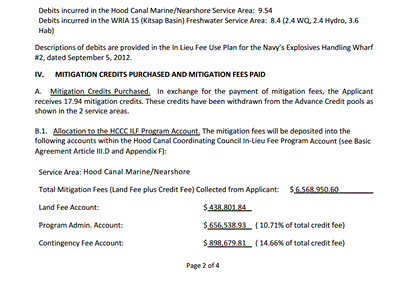See on Scoop.it – Nature + Economics
I guess you pay a lot for mitigation when you’re building an explosives handling wharf. The Navy is building a new wharf in Hood Canal at their Kitsap-Bangor base (about 30 miles NW of Seattle, WA) which will overlay 6.3 acres of water. The cost of each ILF credit? $835,034, coming to a total of over $6 million. I would love to see this check:
 Link for this mighty sales receipt.
Link for this mighty sales receipt.
Cost of building the new explosives handling wharf: $715 million
Cost of compensatory mitigation: $6.9 million
Mitigation cost as percent of total: <1%
The Hood Canal Coordinating Council In Lieu Fee Compensatory Mitigation Program (ILF) created in part to mitigate for this Naval base wharf expansion. The Council that sponsored the ILF is made up of 3 counties and two tribes. The ILF seems to have ruffled feathers with one county commissioner, who was surprised to find the ILF managers had already been in talks with the state department of transportation without the County Commissioner’s knowledge.
This article does a great job of explaining the ILF’s debit/credit methodology in plain language:
“On the debit side, the process begins with an estimate of the amount of habitat affected. For example, the damage from the wharf pilings alone was calculated to be .15 acre. Where the wharf casts a shadow on relatively shallow water, effects on eelgrass, kelp and other underwater plants are calculated at the full area of coverage, or about 0.25 acre.
-snip-
After acreage is calculated for each habitat type, the totals are multiplied by factors for impact and risk. Areas with partial shading, for example, are considered to have a lower impact than full shading. Risk relates to the ability to replace the lost habitat, based on experience and the types of plants and animals being displaced. Eelgrass, for example, has proved difficult to grow in new areas, so those areas get a higher risk factor.
For the Navy’s wharf, the greatest number of debits (2.44) were accumulated on the terrestrial edge of the shoreline, followed by 2.0 debits for subtidal vegetated areas, 1.8 for subtidal nonvegetated areas, 1.51 for nonvegetated beach areas, and so on.”
In related Washington state news, Naval Station Everett just spent $317,000 for compensatory mitigation of a $2.5 million small craft launch dock. The Everett base is about 40 miles (as the car drives) northeast across Puget Sound from the above-mentioned Kitsap-Bangor base.


